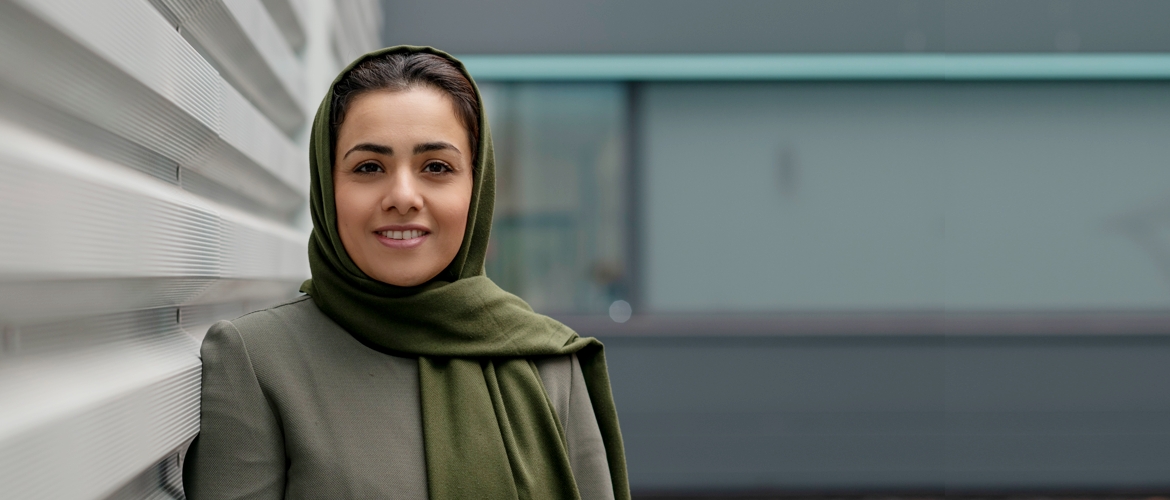Dr Sara Sangtarash

Dr Sara Sangtarash
Associate Professor
Materials and devices for quantum switching and sensing
Sara dot Sangtarash at warwick dot ac dot uk
+44 (0) 24 7652 4714
Biography
Dr. Sangtarash is an Associate Professor in Nanoelectronics and Leverhulme FellowLink opens in a new window in the School of Engineering at the University of Warwick. She obtained her PhD from Lancaster University as a Marie-Curie Early Stage Researcher, developing the theory of nanoscale transport, within the EU Innovative Training Network MOLESCOLink opens in a new window“Molecular-scale Electronics: Concepts, Contacts and Stability” . She was awarded the Lancaster JUNO Prize for research excellence in 2016. After finishing her PhD, she became a Senior Research Associate at Physics department, Lancaster University and in 2018 she awarded a Leverhulme Trust Early Career Fellowship working on material engineering for high-performance molecular-scale thermoelectricity. Dr Sangtarash joined the University of Warwick in 2020.
Research Interests
|
|
|
Research Overview
Magic ratios and mid gap theory for molecular electronics
Magic ratio theory provides a simple but accurate design tool to predict electrical codncutance and thermoelectricity in graphene like molecules.
Selected related publications
- S Sangtarash, Theory of mid-gap quantum transport through single molecule:new approach to transport modeling of nanoelectronic devicesLink opens in a new window, PhD thesis, 2017.
- S Sangtarash, et al., JACS, 2015. DOI: 10.1021/jacs.5b06558Link opens in a new window.
- S Sangtarash, et al., Nanoscale, 2016. DOI: 10.1039/C6NR01907BLink opens in a new window
- Y Geng, et al., JACS, 2015. DOI: 10.1021/jacs.5b00335Link opens in a new window
- S Sangtarash, et al., Phys. Chem. Chem. Phys., 2018. DOI: 10.1039/C8CP00381ELink opens in a new window
-
A Daaoub, et al., Angew. Chem. Int. Ed., 2023. DOI: 10.1002/anie.202302150nk opens in a new window
Graphene nanoribbon electronics
Graphene nanoribbons (GNRs) are quasi one-dimensional single-atom-thin carbon-based nanostructures. Their electronic properties can be controlled by engineering their shape and edge structure which makes them attractive for nanoelectronic applications.
Selected related publications
- ML Abbassi, et al, ACS Nano, 2020, DOI: 10.1021/acsnano.0c00604Link opens in a new window
- P Rémy, et al. JACS, 2020, DOI: 10.1021/jacs.0c03946Link opens in a new window
- ML Abbassi, et al, Nature Nanotechnology, 2019, DOI: 10.1038/s41565-019-0533-8Link opens in a new window
- J Zhang, et al, Nature Electronics, 2023. DOI: 10.1038/s41928-023-00991-3
Quantum interference for molecular electronics
Quantum interference can be used to enhance electronic properties of molecular junctions at room temperature.
Selected related publications
- S Sangtarash, 2021, arXiv:2102.09936Link opens in a new window
- W Chuanli, et al. Nano Letters, 2020, DOI: 10.1021/acs.nanolett.0c02815Link opens in a new window
- S Sangtarash, et al. Nanoscale Advances, 2020, DOI: 10.1039/C9NA00649DLink opens in a new window
- Bai et al, Nature Materials, 2019. DOI: 10.1038/s41563-018-0265-4Link opens in a new window
-
S Naghibi, et al., Angew. Chem. Int. Ed., 2022. DOI: 10.1002/anie.202116985
Teaching Interests
ES191: Electrical and Electronic Circuits
ES195: Materials for Engineering
ES197: Systems Modelling, Simulation and Computation
Publications
For full list visit: https://scholar.google.com/citations?user=4dOA1MoAAAAJ&hl=en
Projects and Grants
- EPSRC new investigator award, May 2023: responsive mode, Principle investigator
Project Title: Quantum Engineering of Atomically Precise Nanoclusters for Cooling and Energy Harvesting (NanoCool)
Value: £447K | Duration: 01/02/2025 - 31/01/2028 - Horizon Europe EIC PathFinderOpen - UKRI InnovateUK Guarantee Scheme, Co-investigator, No: 101099098
Project Title: Atomically Precise Nanoribbons Quantum Platform (ATYPIQUAL).
Duration: 01/10/2023 - 31/03/2027 - The Leverhulme Trust Early Career Fellowship, (Covid Extension)
Duration: 01/05/2022 - 30/04/2024 - The Leverhulme Trust Early Career Fellowship, Principle investigator, No: ECF-2018-375
Project Title: Quantum engineering of high-performance molecular-scale thermoelectricity.
Duration: 01/05/2019 - 30/04/2022
